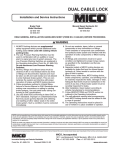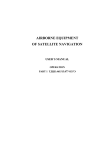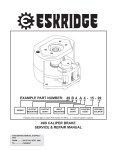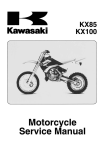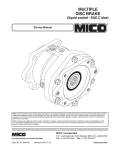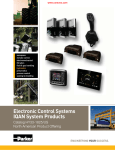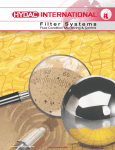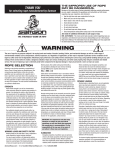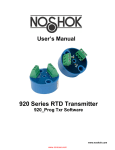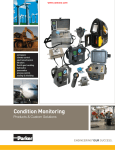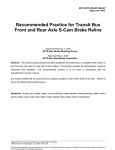Download Eskridge 49B Caliper Service
Transcript
t 49B CALIPER BRAKE TECHNICAL BULLETIN AND SUPPLEMENT TO SERVICE MANUAL This document consists of MICO instructions that apply to the Eskridge 49B Caliper Brake. CONTENTS 81-600-001 General Guidelines to install Hydraulic Brake Components .. 2 81-950-016 Burnishing Procedures ............................................................... 3 81-950-016 Reduce Exposure to Non-Asbestos Fiber ................................. 4 81-515-007 Spring Apply Sliding Caliper Disc Brakes ................................. 5 81-515-008 Hydraulic Apply Sliding Caliper Disc Brakes ............................ 9 81-515-009 Mechanical Sliding Caliper Disc Brakes ................................. 12 THIS TECHNICAL BULLETIN IS EFFECTIVE FROM: .......... S/N 57755, SEPT. 1998 TO: ............... CURRENT REF: .............. TB49B-MICO-AA www.comoso.com General Guidelines for installing Hydraulic Brake Components 81-600-001 General Guidelines for installing Hydraulic Brake How to Mount Components To properly mount components and brake lines to withstand the MICO Hydraulic Brake Components are precision built devices and must be treated as such. The following guidelines must be followed at the time of installation to ensure optimum performance. Where to Mount To properly locate the brake component or brake line, you must. . . 1. Make it convenient for operator. 2. Use the shortest and most protected route. Protect components from road salts and general debris. 3. Avoid exposing components and lines in wheel compartments. 4. Avoid mounting near engine, exhaust lines, muffler or anywhere that heat may be generated. NOTE: Excessive heat transferred to brake fluid may result in damage to lines or seals. 5. Mount units that have to be bled lower than master cylinder and with bleeder screws on top to facilitate bleeding. Internal Heat - Cause, Effect, Solution It is possible for heat to come from within the system itself as in the case of heat generated by the friction of lining to drum when braking. This heat can cause the fluid to expand. If the fluid is then held captive, subsequent cooling and contracting can cause a pressure drop. MICO Hydraulic Locking Devices that include a pressure accumulator are designed to dampen these fluctuations of pressure and to absorb the increase in pressure within its operating range. Cleanliness It is impossible to overemphasize the importance of cleanliness during installation. All lines, fittings and adjacent areas must be cleaned of dirt or road residue before any lines or fittings are disconnected. Special care must be taken so dirt and road residue are not allowed to enter the hydraulic brake system. This can contaminate the system and interfere with the proper operation of the brakes and other hydraulic components. Always. . . 1. Use good, clean, quality fluid. Improper or contaminated brake fluid may cause gummy deposits and softening and swelling of other rubber seals in the entire brake system. Such a condition must be corrected immediately. a. Use brake fluid which conforms to SAE Spec. No. J1703 or DOT 3 or 4 if the product is used with a system utilizing automotive brake fluid. b. Refer to vehicle manufacturer for fluid specification if product is used with: 1. Mineral based hydraulic oil. 2. Phosphate ester base fluid. 3. Water/glycol fluid. 4. Water-in-oil emulsion fluid. 5. DOT 5 or silicone fluid. 2. Be sure fittings and seats are clean before making connections. Do not use sealants, tapes, teflon or cement compounds on any connections or fittings. These sealants or compounds can contaminate the hydraulic brake system and interfere with the operation of brake system components. 3. Clean top of master cylinder before removing filler cap. most severe vibration conditions, always. . . 1. Follow the procedures outlined in Vehicle Manufacturer’s Service Manual or SAE Standards when making new connections or adding to existing brake system. Use only steel brake tubing conforming to SAE specifications. 2. Use the proper size bolt for the hole and secure with a steel lock washer whenever possible. 3. Secure tubing to frame with proper size tube clamps to avoid possible fractures or fittings loosening and leaking. 4. Use good, factory flared lengths of steel tubing. Hand made flares, when used, must be double flared. Any flash or loose particles must be moved. 5. Use flexible brake line between frame and body. 6. Use grommets or some other means to protect brake lines that pass through the frame or firewall. 7. Make sure fittings and connections are in good condition and tightened to proper torque values as specified in the installation and service instructions. Importance of Bleeding The hydraulic brake system must be bled whenever any line has been disconnected. Air trapped in the system can cause spongy and inadequate brakes. There are two methods of bleeding hydraulic systems, pressure bleeding and manual bleeding. Both methods are acceptable and adequate but pressure bleeding is recommended if the equipment is available. Follow bleeding instructions as specified by vehicle manufacturer. To properly bleed the system. . . 1. Be certain all fittings are tight to avoid leaking. 2. Depress pedal and open up bleeder screws to allow air to escape. Air will always seek the highest level. 3. Retighten bleeder screws and allow pedal to return. 4. Repeat cycle until pedal is firm. 5. Make several static brake applications and then repeat cycle once more. Leak in the System Even the smallest leak in a brake system will adversely affect the system. A leak may eventually deplete the reserve supply and reduce braking pressure. To help prevent leaking. . . 1. Check connections during bleeding and static brake processes to be sure they are tight. 2. Always reinstall new hoses, lines and fittings if they look the least bit questionable. 3. Brake hoses, brake lines, MICO locking device, brake components, cylinders, and all fittings must be routinely inspected for leaks, damage or wear. Adequate fluid levels must be maintained. In the event of any loss of fluid, the brake system must be carefully inspected for leaks. MICO has made every attempt to present accurate information in catalogs, brochures and other printed material. MICO can accept no responsibility for errors from unintentional oversights that may exist. Due to a continuous program of product improvement, both materials and specifications are subject to change without notice or obligation. MICO is a registered trademark of MICO, Incorporated. MICO is registered in the U.S. Patent and Trademark Office as well as in Canada, Great Britain, South Korea and Australia. MICO, Incorporated MICO West Division 1911 Lee Boulevard (Zip Code 56003-2507) P.O. Box 8118 / North Mankato, MN U.S.A. 56002-8118 ( (507) 625-6426 Facsimile (507) 625-3212 701 East Francis Street (Zip Code 91761-5514) P.O. Box 9058 / Ontario, CA U.S.A. 91762-9058 ( (909) 947-4077 Facsimile (909) 947-6054 Form No. 81-600-001 Revised 5/97 Printed in U.S.A. www.comoso.com Burnishing Procedures 81-950-016 BURNISHING PROCEDURES for MICO Caliper Disc Brakes 81-950-016 Burnishing Procedures FOR MICO CALIPER DISC BRAKES TECHNICAL NOTICE Maximum torque will be achieved only after the brake has been properly burnished. Actual customer testing will be required to determine final acceptance and approval of brake system components. MICO recommends the following SAE burnishing procedures be performed immediately following the installation and adjustment of the brake. These “SAE recommended practices” (J360; paragraph 7.3 for parking brakes and J786a; paragraph 5.5 for service brakes) are intended to be used as guidelines only. Contact the vehicle (or equipment) manufacturer for specific recommendations. PARKING BRAKE: Make 10 stops from 10 mph (45 m/s) at 3 ft/s2 (0.9 m/s2). Space the stops a minimum of 2.5 miles (4000 m) apart and operate the vehicle at 20 mph (9 m/s) between stops. SERVICE BRAKE: Make at least 200 “Brake Snubs”, not less than 50 in a series, from 40 to 20 mph (64 to 32 km/hr.) at 10 ft/s2 (3 m/s2) in normal gear range. [A “Brake Snub” is the act of retarding a motor vehicle between two positive speed values by the use of a brake system.] Accelerate to 40 mph at moderate acceleration after each “snub” and drive 40 mph (64 km/hr) between snubs. At every 25th application (minimum), make a full stop from 40 mph (46 km/hr.). APPLICATION INTERVALS: • For light trucks and buses [6,000-10,000 lb. (2,700-4,500kg) GVW]: 1.0 mile (1.6 km) • For truck, bus, and combination of vehicles [over 10,000 lb. (4,500 kg) GVW]: 1.5 miles (2.4 km) NOTE: Other burnish procedures which produce similar braking conditions and performance characteristics are permissible. After burnishing, adjust the parking brake and actuation system in accordance with MICO specifications (or the appropriate manufacturer’s specifications for components of the actuation system not supplied by MICO). Immediately following any dynamic stop resulting from the application of the parking brake, the brake and disc must be inspected for any unusual wear or conditions and then adjusted in accordance with MICO specifications. Recommended Disc Material High quality brake discs should be used in conjunction with MICO Caliper Disc Brakes. Depending on strength and performance requirements, low to medium carbon steel is generally recommended. Fabrication procedures are as follows: 1. Flame cut or machine to required outside diameter with inside diameter machined to size. 2. Stress relieve after all machining operations. 3. Blanchard ground to a surface finish of 54 Ra to 72 Ra with a visible crosshatch pattern. 4. Surfaces to be parallel within .05 mm (.002"). 5. Surfaces to be flat within .13 mm (.005"). MICO could not possibly know of and give advice with respect to all conceivable applications in which this product may be used and the possible hazards and/or results of each application. MICO has not undertaken any such wide evaluation. Therefore, anyone who uses an application which is not recommended by the manufacturer, first must completely satisfy himself that a danger will not be created by the application selected, or by the particular model of our product that is selected for the application. MICO has made every attempt to present accurate information in catalogs, brochures and other printed material. MICO can accept no responsibility for errors from unintentional oversights that may exist. Due to a continuous program of product improvement, both materials and specifications are subject to change without notice or obligation. MICO is a registered trademark of MICO, Incorporated. MICO is registered in the U.S. Patent and Trademark Office as well as in Canada, Great Britain, South Korea, and Australia. MICO, Incorporated MICO West Division 1911 Lee Boulevard (Zip Code 56003-2507) P.O. Box 8118 / North Mankato, MN U.S.A. 56002-8118 ( 507.625.6426 Facsimile 507.625.3212 701 East Francis Street (Zip Code 91761-5514) P.O. Box 9058 / Ontario, CA U.S.A. 91762-9058 ( 909.947.4077 Facsimile 909.947.6054 Form No. 81-950-016 Revised 10/14/98 www.comoso.com Printed in U.S.A. 81-950-016 Recommended Procedures to Reduce ExpoRecommended Brake Service Procedures sure to Non-Asbestos Fiber 81-950-016 Burnishing Procedures to Reduce Exposure to Non-Asbestos Fiber for MICO Caliper Disc Brakes TECHNICAL NOTICE FOR ALL MICO NON-ASBESTOS BRAKE LININGS Recently manufactured brake linings no longer contain asbestos fibers. In place of asbestos, these linings contain a variety of ingredients, including glass fibers, mineral wool, aramid fibers, ceramic fibers, and carbon fibers. At present, OSHA does not specifically regulate these non-asbestos fibers, except as nuisance dust. Medical experts do not agree about the potential long-term risks from working with and 1. Whenever possible, work on brakes in a separate area away from other operations. 2. Always wear a respirator approved by NIOSH or MSHA during all brake service procedures. Wear the respirator from removal of the wheels through assembly. 3. NEVER use compressed air or dry brushing to clean brake parts or assemblies. OSHA recommends that you use cylinders that enclose the brake. These cylinders have vacuums with high efficiency (HEPA) filters and worker’s arm sleeves. But, if such equipment is not available, carefully clean parts and assemblies in the open air. 4. During disassembly, carefully place all parts on the floor to avoid getting dust into the air. Use an industrial vacuum cleaner with a HEPA filter system to clean dust from the brake drums, backing plates and other brake parts. After using the vacuum, remove any remaining dust with a rag soaked in water and wrung until nearly dry. 5. Grinding or machining brake linings. If you must inhaling non-asbestos fibers. Some experts nonetheless think that long-term exposure to some non-asbestos fibers may cause diseases of the lung, including pneumoconiosis, fibrosis and cancer. Therefore, MICO recommends that workers use caution to avoid creating and breathing dust when working on brakes that contain non-asbestos fibers. grind or machine brake linings, take additional precautions because contact with fiber dust is higher during these operations. In addition to wearing an approved respirator, do such work in an area with exhaust ventilation. 6. Cleaning the work area. NEVER use compressed air or dry sweeping to clean the work area. Use an industrial vacuum with a HEPA filter and rags soaked in water and wrung until nearly dry. Dispose of used rags with care to avoid getting dust into the air. Use an approved respirator when emptying vacuum cleaners and handling used rags. 7. Worker clean-up. Wash your hands before eating, drinking or smoking. Do not wear your work clothes home. Vacuum your work clothes after use and then launder them separately, without shaking, to prevent fiber dust from getting into the air. 8. Material safety data sheets on this product, as required by OSHA, are available from MICO. MICO could not possibly know of and give advice with respect to all conceivable applications in which this product may be used and the possible hazards and/or results of each application. MICO has not undertaken any such wide evaluation. Therefore, anyone who uses an application which is not recommended by the manufacturer, first must completely satisfy himself that a danger will not be created by the application selected, or by the particular model of our product that is selected for the application. MICO has made every attempt to present accurate information in catalogs, brochures and other printed material. MICO can accept no responsibility for errors from unintentional oversights that may exist. Due to a continuous program of product improvement, both materials and specifications are subject to change without notice or obligation. MICO is a registered trademark of MICO, Incorporated. MICO is registered in the U.S. Patent and Trademark Office as well as in Canada, Great Britain, South Korea and Australia. MICO, Incorporated MICO West Division 1911 Lee Boulevard (Zip Code 56003-2507) P.O. Box 8118 / North Mankato, MN U.S.A. 56002-8118 ( 507.625.6426 Facsimile 507.625.3212 701 East Francis Street (Zip Code 91761-5514) P.O. Box 9058 / Ontario, CA U.S.A. 91762-9058 ( 909.947.4077 Facsimile 909.947.6054 Form No. 81-950-016 Revised 10/14/98 Printed in U.S.A. www.comoso.com Installation and Service Instructions APPLY 81-515-007 SpringSPRING Apply Sliding Caliper Disc Brakes Sliding Caliper Disc Brakes 515 SERIES TABLE 1 Model Lining Seal Repair Model Lining Seal Number Kit Kit Kit Number Kit Kit 02-515-001 (BF) 20-060-082 02-500-037 02-500-192 * 02-515-152 (HO) 20-060-082 02-500-095 02-515-002 (HO) 20-060-082 02-500-036 02-500-187 02-515-154 (HO) 20-060-082 02-500-036 02-515-003 (BF) 20-060-082 02-500-037 02-500-193 * 03-515-003 (BF) 20-060-082 02-500-137 02-515-004 (HO) 20-060-082 02-500-036 02-500-186 * 03-515-004 (HO) 20-060-082 02-500-095 02-515-005 (BF) 20-060-082 02-500-037 02-500-194 * 03-515-005 (BF) 20-060-082 02-500-137 02-515-006 (HO) 20-060-082 02-500-036 02-500-188 * 03-515-006 (HO) 20-060-082 02-500-095 02-515-007 (BF) 20-060-082 02-500-037 02-500-195 * 03-515-008 (HO) 20-060-082 02-500-095 02-515-008 (HO) 20-060-082 02-500-036 02-500-190 * 03-515-013 (BF) 20-060-082 02-500-139 02-515-012 (HO) 20-060-082 02-500-036 02-500-189 * 03-515-014 (HO) 20-060-082 02-500-095 02-515-018 (HO) 20-060-036 02-500-036 02-500-188 * 03-515-016 (HO) 20-060-082 02-500-095 02-515-020 (HO) 20-060-082 02-500-036 02-500-190 * 03-515-018 (HO) 20-060-082 02-500-095 02-515-022 (HO) 20-060-082 02-500-077 None * 03-515-023 (BF) 20-060-082 02-500-137 02-515-024 (HO) 20-060-082 02-500-077 02-500-197 * 03-515-028 (HO) 20-060-082 02-500-095 02-515-028 (HO) 20-060-082 02-500-077 None 03-515-034 (HO) 20-060-082 02-500-036 02-515-038 (HO) 20-060-082 02-500-036 02-500-191 03-515-036 (HO) 20-060-082 02-500-036 02-515-044 (HO) 20-060-082 02-500-036 02-500-216 03-515-038 (HO) 20-060-082 02-500-095 02-515-119 (BF) 20-060-082 02-500-037 02-500-196 * 03-515-104 (HO) 20-060-082 02-500-208 BF = Brake Fluid HO = Mineral Base Hydraulic Oil * With swivel inlet fitting (See swivel fitting block drawing, Figure 5, on page three). ·Belleville Springs are pre-greased, DO NOT remove grease from springs (See GREASE NOTE in Figure 4). Repair Kit · 02-500-199 02-500-186 02-500-205 02-500-200 02-500-204 02-500-201 02-500-202 02-500-205 02-500-200 02-500-201 02-500-202 02-500-205 02-500-202 02-500-200 02-500-186 02-500-203 02-500-209 READ GENERAL INSTALLATION GUIDELINES SHEET (81-600-001) BEFORE PROCEEDING MICO Disc Brake Linings do not contain asbestos. Brake lining compounds do, however, contain elements that may become airborne during the life of the lining. To prevent any health problems associated with lining dust, we suggest ventilators be installed as needed on enclosed or stationary equipment. A Material Safety Data Sheet is available upon request. When installing these MICO 515 Series Brakes, it is of utmost importance to maintain parallelism between mounting bolts and that caliper be centered evenly and squarely over disc. This will prevent binding of caliper and ensure even lining to disc contact. These MICO 515 Series Brakes are designed to be used with a disc thickness of 12.7 mm (.50"). For other disc thicknesses, contact MICO, Inc. DISC CENTERLINE TO MOUNTING HOLE DIMENSION millimeters inches FIGURE 1 DISC DIA. 152.4 mm (6") 203.2 mm (8") 254.0 mm (10") 304.8 mm (12") 355.6 mm (14") 406.4 mm (16") 457.2 mm (18") 508.0 mm (20") "A" DIM. 85.9 mm (3.38") 111.3 mm (4.38") 136.7 mm (5.38") 162.1 mm (6.38") 187.5 mm (7.38") 212.9 mm (8.38") 238.3 mm (9.38") 263.7 mm (10.38") TABLE 2 For disc diameters greater than 508.0 mm, add 9.7 mm (20", add .38") to disc radius to obtain "A" dimension. www.comoso.com FIGURE 2 MOUNTING PROCEDURE 1. Using Figure 1 and Table 2, determine “A” dimension and locate caliper mounting holes. 2. Distance from mounting surface to head of mounting bolt is 82.6 mm (3.25") regardless of disc thickness. 3. Mount brake on disc and bolt securely to vehicle or machine using grade 5 or better mounting bolts or pins. NOTE: Due to the extreme pressure created by the belleville springs (11), the procedure shown in Figure 3 is needed to disassemble brake module housing (7). HYDRAULIC CONNECTION & ADJUSTMENT PROCEDURE (Refer to Figure 4) Port Size: #4 SAE O-ring Boss 1. Install hydraulic line, leaving tube nut slightly loose to allow turning adjustment of brake module. NOTE: The adjusting procedure may be simplified if a swivel fitting is used. (See swivel fitting block chart, Table 3.) 2. Bleed system using bleeder screw (8) at highest point making sure all air is eliminated. FIGURE 3 During the bleeding process for these MICO 515 Series Brakes, hydraulic pressure should not exceed 13.8 bar (200 psi). 3. Apply hydraulic pressure and check for leaks. 4. Apply rated hydraulic pressure. 5. Thread in brake module until a total clearance of approximately .30 mm (.012") is obtained between disc and linings. Use a spanner wrench if necessary. 6. Tighten set screw (16) and release hydraulic pressure. 7. Tighten hydraulic fitting (tube nut). CHANGE SEAL KIT OR REPAIR KIT PROCEDURE (Refer to Figures 3 & 4) millimeters inches 5. Remove wheel puller from brake module housing (7). Carefully remove piston (12), washers (10), belleville springs (11), spacer (9), back-up ring (6), o-ring (5) and insert (4) from brake module housing. Note: Care must be taken so as not to scratch or mar brake module housing bore. See Table 1 for Kit required for your brake. NOTE 1. Disconnect fluid line from brake and remove caliper from vehicle or machine. Cap end of fluid line to prevent entry of dirt into hydraulic system. 2. Remove set screw (16) from housing (19) and remove brake module housing (7) from housing. 3. Position brake module housing (7) in a wheel puller (Refer to Figure 3). Apply force until piston (12) retracts approximately .80 mm (.03"). Using a spanner wrench, remove piston (1). 4. Carefully remove o-ring (3) and back-up ring (2) from piston (1). NOTE: Care must be taken so as not to scratch or mar piston. Note number and order of belleville springs (11), washers (10) and spacer (9) for assembly purposes. 6. Remove cup (13) from piston (12). NOTE: In older models item 13 will be an o-ring. 7. Clean all parts thoroughly and lubricate all rubber components from seal kit or repair kit with clean type system fluid. 8. Carefully install new back-up ring (6), new o-ring (5) and insert (4) in brake module housing (7). Note order of back-up ring and o-ring. 9. Carefully install new o-ring (3) and new back-up ring (2) on piston (1). Note order of o-ring and back-up ring. 10. Carefully install piston (1) into brake module housing (7). 11. Lubricate all items as shown in Figure 4 with a light www.comoso.com coat of heavy, waterproof grease (See GREASE NOTE, Figure 4). Install belleville springs (11), washers (10) and spacer (9) into brake module housing (7). NOTE: If seal kit is being installed use existing belleville springs after completely lubricating with a light coat of heavy, waterproof grease (See GREASE NOTE, Figure 4). If repair kit is being installed use new belleville springs, already greased. Be sure to use the same number of belleville springs and washers in the same order as when they were disassembled. 12. Install new cup (13) on piston (12) and carefully install in brake module housing (7) by threading onto piston (1). Note direction of cup. 13. Reposition brake module housing (7) in wheel puller (Refer to Figure 3). Apply force until piston (12) moves approximately .80 mm (.03"). Using a spanner wrench, tighten piston (1) securely. 14. Remove wheel puller. 15. Install brake module housing (7) into housing (19). Hand tighten brake module housing. FIGURE 4 Items included in Seal Kit · s Items included in Repair Kit n ] Items included in Lining Kit Not included in all Lining Kits GREASE NOTE NOTE: The number and order of belleville springs (11) and washers (10) vary from model to model. Size and location of spacer (9) also varies from model to model. Some models do not use washers and/or spacers. Brake Fluid Models must use a silicone base grease. Hydraulic Oil Models must use a mineral base grease. OPTIONAL SWIVEL FITTING BLOCK MODELS 1/8-27 NPTF 02-515-152 03-515-003 03-515-004 03-515-005 03-515-006 03-515-008 03-515-104 # 4 SAE O-ring Boss 03-515-013 03-515-014 03-515-016 03-515-018 TABLE 3 1/4 Inverted Tube Seat 03-515-023 03-515-028 millimeters inches www.comoso.com FIGURE 5 16. Install flexible hydraulic line, leaving tube nut slightly loose to allow turning adjustment of brake module. NOTE: The adjusting procedure may be simplified if a swivel fitting is used. (See swivel fitting block chart, Table 3.) 17. Remove bleeder screw (8). Adjust module housing (7) so bleeder screw port is at the highest point and bleed system of air. Install new screw (8) and torque 12.4-13.6 N-m (110-120 lb-in). During the bleeding process for these MICO 515 Series Brakes, hydraulic pressure should not exceed 13.8 bar (200 psi). 18. Apply hydraulic pressure and check for leaks. 19. Apply rated hydraulic pressure. 20. Thread in brake module housing (7) until a total clearance of approximately .30 mm (.012") is obtained between disc and lining assemblies (18). Use a spanner wrench if necessary. 21. Insert new nylon plug (15) into set screw (16) hole. Install nylon plug (15) even if originally not included on your model. 22. Install and tighten set screw (16) and release hydraulic pressure. 23. Tighten hydraulic fitting (tube nut). Items included in Seal Kit · s Items included in Repair Kit n ] Items included in Lining Kit Not included in all Lining Kits FIGURE 6 CHANGE LINING PROCEDURE (Refer to Figure 6) See Table 1 for Lining Kit required for your brake. Lining assemblies (18) can be replaced without removing brake module housing (7). 1. Remove cap screw (14) and spring clip (17); allow lining assemblies (18) to drop out of housing (19). NOTE: On small diameter discs with large hubs, it may be necessary to remove one mounting bolt and swing housing aside to free lining assemblies. Earlier models used a compression spring which is not included in the lining kit. 2. Thread brake module housing (7) out of housing (19) so that piston (12) is flush with housing. 3. Install new lining assemblies (18) in housing (19). 4. Install new spring clip (17) and cap screw (14) and torque 13.6-16.3 N-m (10-12 lb-ft). NOTE: If the lining kit does not include new spring clip (17), reinstall compression spring. To continue, refer to HYDRAULIC CONNECTION & ADJUSTMENT PROCEDURE Section. MICO could not possibly know of and give advice with respect to all conceivable applications in which this product may be used and the possible hazards and/or results of each application. MICO has not undertaken any such wide evaluation. Therefore, anyone who uses an application which is not recommended by the manufacturer, first must completely satisfy himself that a danger will not be created by the application selected, or by the particular model of our product that is selected for the application. MICO has made every attempt to present accurate information in catalogs, brochures and other printed material. MICO can accept no responsibility for errors from unintentional oversights that may exist. Due to a continuous program of product improvement, materials, specifications, and product documentation are subject to change without notice or obligation. MICO is a registered trademark of MICO, Incorporated. MICO is registered in the U.S. Patent and Trademark Office as well as in Canada, Great Britain, South Korea, Australia, and Japan. MICO, Incorporated MICO West Division 1911 Lee Boulevard (Zip Code 56003-2507) P.O. Box 8118 / North Mankato, MN U.S.A. 56002-8118 ( 507.625.6426 Facsimile 507.625.3212 701 East Francis Street (Zip Code 91761-5514) P.O. Box 9058 / Ontario, CA U.S.A. 91762-9058 ( 909.947.4077 Facsimile 909.947.6054 Form No. 81-515-007 Revised 2/27/01 Printed in U.S.A. www.comoso.com Installation and Service Instructions HYDRAULIC APPLY 81-515-008 Hydraulic Apply Sliding Caliper Disc Brakes Sliding Caliper Disc Brakes 515 SERIES TABLE 1 Model Number Lining Kit Repair Kit Model Number Lining Kit Repair Kit 02-515-025 (BF) 02-515-030 (HO) 02-515-036 (HO) 20-060-082 20-060-082 20-060-063 02-500-039 02-500-038 02-500-038 02-515-041 (BF) 02-515-042 (HO) 20-060-082 20-060-082 02-500-039 02-500-038 BF = Brake Fluid HO = Mineral Base Hydraulic Oil READ GENERAL INSTALLATION GUIDELINES SHEET (FORM NO. 81-600-001) BEFORE PROCEEDING. MICO Disc Brake Linings do not contain asbestos. Brake lining compounds do, however, contain elements that may become airborne during the life of the lining. To prevent any health problems associated with lining dust, we suggest ventilators be installed as needed on enclosed or stationary equipment. A Material Safety Data Sheet is available upon request. When installing these MICO 515 Series Brakes, it is of utmost importance to maintain parallelism between mounting bolts and that caliper be centered evenly and squarely over disc. This will prevent binding of caliper and ensure even lining to disc contact. MOUNTING PROCEDURE 1. Using Figure 1 and Table 2, determine “A” dimension and locate caliper mounting holes. 2. Distance from mounting surface to head of mounting bolt is 82.6 mm (3.25") regardless of disc thickness. 3. Mount brake on disc and bolt securely to vehicle or machine using grade 5 or better mounting bolts or pins. Models 02-515-041 & 02-515-042 are designed to be used with a disc thickness of 6.4-9.5 mm (.250"-.375"). All other models listed in Table 1 are designed to be used with a disc thickness of 12.7 mm (.50"). For other disc thicknesses, contact MICO, Inc. DISC CENTERLINE TO MOUNTING HOLE DIMENSION DISC DIA. “A” DIM. 152.4 mm (6") 85.9 mm (3.38") 203.2 mm (8") 111.3 mm (4.38") 254.0 mm (10") 136.7 mm (5.38") 304.8 mm (12") 162.1 mm (6.38") 355.6 mm (14") 187.5 mm (7.38") 406.4 mm (16") 212.9 mm (8.38") 457.2 mm (18") 238.3 mm (9.38") 508.0 mm (20") 263.7 mm (10.38") millimeters inches FIGURE 1 TABLE 2 For disc diameters greater than 508.0 mm, add 9.7 mm (20", add .38") to disc radius to obtain “A” dimension. www.comoso.com FIGURE 2 HYDRAULIC CONNECTION & ADJUSTMENT PROCEDURE (Refer to Figure 3) Port Size: 1/8-27 NPTF 1. Thread in brake module housing (2) until a total clearance of approximately .30 mm (.012") is obtained between disc and linings. NOTE: Make sure piston (5) is bottomed out in brake module housing (2). 2. Back off brake module housing (2) as required to position ports in vertical alignment. 3. Tighten set screw (8). 4. Move bleeder screw (1) to higher of two ports for ease of bleeding. Torque bleeder screw (1) 16.3-19.0 N-m (12-14 lb-ft). 5. Install hydraulic line in lower port. 6. Bleed system making sure all air is eliminated. During the bleeding process for these MICO 515 Series Brakes, hydraulic pressure should not exceed 13.8 bar (200 psi). 7. Apply rated hydraulic pressure and check for leaks. 6. Carefully install new o-ring (3) and new back-up ring (4) on piston (5). Note order of back-up ring and o-ring. 7. Lubricate piston (5) with clean type system fluid and install in brake module housing (2). Note direction of piston and be sure it is bottomed out in brake module. 8. Thread brake module housing (2) into housing (11) until a total clearance of approximately .30 mm (.012") is obtained between disc and linings. 9. Back off brake module housing (2) as required to position ports in vertical alignment. 10. Insert new nylon plug (7) into set screw (8) hole. Install nylon plug (7) even if originally not included on your model. 11. Install and tighten set screw (8). 12. Move bleeder screw (1) to higher of two ports for ease of bleeding. Torque bleeder screw (1) 16.3-19.0 N-m (12-14 lb-ft). 13. Install hydraulic line in lower port. 14. Bleed system making sure all air is eliminated. Apply hydraulic pressure and check for leaks. CHANGE LINING PROCEDURE (Refer to Figure 3) See Table 1 for Lining Kit required for your brake. Lining assemblies (10) can be replaced without removing brake module housing (2). CHANGE SEAL PROCEDURE (Refer to Figures 3 & 4) See Table 1 for Repair Kit required for your brake. 1. Disconnect necessary fluid line from brake and remove caliper from vehicle or machine. Cap end of fluid line to prevent entry of dirt into hydraulic system. 2. Remove set screw (8) from housing (11) and remove brake module housing (2) from housing (11). 3. Place brake module housing (2) face down on bench, support brake module so piston (5) can be eased out of bore. This is accomplished by carefully introducing low air pressure, .7-1.0 bar (10-15 psi), through the hydraulic line port. Do not use high pressure as it is dangerous and unnecessary. Use just enough air pressure to ease the piston out of the bore. Do not blow piston out of the bore. If the piston is seized or cocked or does not come out readily, release the air pressure and use a soft (brass) hammer to rap sharply on and around the end of the piston. Reapply air pressure to remove the piston. 1. Remove cap screw (6) and spring clip (9); allow lining assemblies (10) to drop out of housing (11). NOTE: On small diameter discs with large hubs, it may be necessary to remove one mounting bolt and swing housing aside to free lining assemblies. Earlier models used a compression spring which is not included in the lining kit. 2. Make sure piston (5) is bottomed out in brake module housing (2). Loosen set screw (8) and thread brake module housing (2) out of housing (11) so piston (5) is flush with housing (11). 3. Install new lining assemblies (10) in housing (11). 4. Install new spring clip (9) and cap screw (6) and torque 13.6-16.3 N-m (10-12 lb-ft). NOTE: If the lining kit does not include new spring clip (9) reinstall compression spring. 5. To continue, refer to HYDRAULIC CONNECTION & ADJUSTMENT PROCEDURE Section. 4. Remove o-ring (3) and back-up ring (4) from piston (5). NOTE: Be careful not to scratch or mar piston. 5. Clean all parts thoroughly and lubricate all rubber components from Repair Kit with clean type fluid used in the system. www.comoso.com FIGURE 3 s Items included in Lining Kit Items included in Repair Kit ∗ Not included in all lining kits l FIGURE 4 MICO could not possibly know of and give advice with respect to all conceivable applications in which this product may be used and the possible hazards and/or results of each application. MICO has not undertaken any such wide evaluation. Therefore, anyone who uses an application which is not recommended by the manufacturer, first must completely satisfy himself that a danger will not be created by the application selected, or by the particular model of our product that is selected for the application. MICO has made every attempt to present accurate information in catalogs, brochures and other printed material. MICO can accept no responsibility for errors from unintentional oversights that may exist. Due to a continuous program of product improvement, both materials and specifications are subject to change without notice or obligation. MICO is a registered trademark of MICO, Incorporated. MICO is registered in the U.S. Patent and Trademark Office as well as in Canada, Great Britain, South Korea, and Australia. MICO, Incorporated MICO West Division 1911 Lee Boulevard (Zip Code 56003-2507) P.O. Box 8118 / North Mankato, MN U.S.A. 56002-8118 ( 507.625.6426 Facsimile 507.625.3212 701 East Francis Street (Zip Code 91761-5514) P.O. Box 9058 / Ontario, CA U.S.A. 91762-9058 ( 909.947.4077 Facsimile 909.947.6054 Form No. 81-515-008 Revised 5/4/99 Printed in U.S.A. www.comoso.com Installation and Service Instructions 81-515-009 Mechanical Sliding Caliper Disc Brakes MECHANICAL Sliding Caliper Disc Brakes 515 SERIES TABLE 1 Model Number 02-515-116 †* 02-515-147 02-515-148 †* 02-515-149 02-515-150 Lining Kit 20-060-036 20-060-082 20-060-082 20-060-082 20-060-082 † † Model Number 02-515-174 02-515-175 02-515-176 02-515-178 02-515-179 Lining Kit 20-060-082 20-060-082 20-060-063 20-060-082 20-060-097 † † Model Number 02-515-180 02-515-186 20-100-297 Lining Kit 20-060-082 20-060-063 20-060-082 * Drive line parking brake package. † Use spacer(s) behind lining (dead side). NOTE: Repair Kit 02-500-133 used with all models. MICO Disc Brake Linings do not contain asbestos. Brake lining compounds do, however, contain elements that may become airborne during the life of the lining. To prevent any health problems associated with lining dust, we suggest ventilators be installed as needed on enclosed or stationary equipment. A Material Safety Data Sheet is available upon request. When installing these MICO 515 Series Brakes, it is of utmost importance to maintain parallelism between mounting bolts and that caliper be centered evenly and squarely over disc. This will prevent binding of caliper and ensure even lining to disc contact. These MICO 515 Series Brakes are designed to be used with a disc thickness of 12.7 mm (.50"). For other disc thicknesses, contact MICO, Inc. MOUNTING PROCEDURE 1. Using Figure 1 and Table 2, determine "A" dimension and locate caliper mounting holes. 2. Distance from mounting surface to head of mounting bolt is 82.6 mm (3.25") regardless of disc thickness. 3. Mount brake on disc and bolt securely to vehicle or machine using grade 5 or better mounting bolts or pins. DISC CENTERLINE TO MOUNTING HOLE DIMENSION DISC DIA. "A" DIM. 150 mm (6") 85.9 mm (3.38") 205 mm (8") 111.3 mm (4.38") 255 mm (10") 136.7 mm (5.38") 305 mm (12") 162.1 mm (6.38") 355 mm (14") 187.5 mm (7.38") 405 mm (16") 212.9 mm (8.38") 455 mm (18") 238.3 mm (9.38") 510 mm (20") 263.7 mm (10.38") TABLE 2 millimeters inches FIGURE 1 For disc diameters greater than 510 millimeters, add 9.7 mm (20 inches, add .38") to disc radius to obtain "A" dimension. www.comoso.com FIGURE 2 ADJUSTMENT PROCEDURE NOTE Do not use lever as a means to turn brake module. To do so will cause piston to extend and create false settings. 1. Thread in brake module housing until lining assemblies contact disc completely. Back off brake module until a flat surface lines up with set screw. Tighten set screw securely. 2. Remove lock nut and lever from piston. Position lever in desired location. 3. Install lock nut on piston. Torque 12.2-14.9 N-m (9-12 lb-ft). 4. Attach actuating mechanism to lever. CHANGE BALL & CAM PROCEDURE (Refer to Figures 3 & 4) NOTE Do not use the operating lever as a means to turn the brake module. 1. Disconnect actuating mechanism from lever (2) and loosen set screw (11). 2. Remove brake module housing (6) and lever assembly from housing (14). 3. Remove lock nut (1) and lever (2) from piston (9). 4. Depress retainer (4) and remove retaining ring (3) from piston (9). 5. Remove retainer (4) and five belleville springs (5) from piston (9). 12. Thread in brake module housing (6) until lining assemblies (12) contact disc completely. Back off brake module until a flat surface lines up with set screw (11). Tighten set screw securely. 13. Install lever (2) in desired location on piston (9). 14. Install lock nut (1) on piston (9). Torque 12.2-14.9 N-m (9-12 lb-ft). 15. Attach actuating mechanism to lever. CHANGE LINING PROCEDURE (Refer to Figure 4) See Table 1 for Lining Kit required for your brake. Lining assemblies (12) can be replaced without removing brake module housing (6). 1. Remove cap screw (10) and spring clip (13); allow lining assemblies (12) to drop out of housing (14). NOTE: On small diameter discs with large hubs, it may be necessary to remove one mounting bolt and swing housing to free lining assemblies. Earlier models used a compression spring which is not included in the lining kit. 2. Thread brake module housing (6) out of housing (14) so that piston (9) is flush with housing. 3. Install new lining assemblies (12) in housing (14). 4. Install new spring clip (13) and cap screw (10) and torque 13.6-16.3 N-m (10-12 lb-ft). NOTE: If the lining kit does not include new spring clip (13), reinstall compression spring. 5. To continue, refer to ADJUSTMENT PROCEDURE Section. NOTE Note stacking sequence of belleville springs (5) for assembly purposes. 6. Remove piston (9), two cam plates (7) and three balls (8) from brake module housing (6). 7. Lubricate three new balls (8) with heavy, waterproof grease and place between ramps of new cam plates (7). 8. Install new cam plates (7) on piston (9) making sure locking lugs are aligned with holes on piston. 9. Install piston (9) assembly into brake module housing (6) making sure locking lugs of cam plate (7) align with holes in brake module housing. Lightly coat face of piston with heavy, waterproof grease. 10. Install five belleville springs (5) and retainer (4) on piston (9). NOTE Note stacking sequence of belleville springs (5). 11. Depress retainer (4) and install retaining ring (3) in groove on piston (9). www.comoso.com FIGURE 3 Items included in Lining Kit Items included in Repair Kit Not included in all Lining Kits FIGURE 4 MICO could not possibly know of and give advice with respect to all conceivable applications in which this product may be used and the possible hazards and/or results of each application. MICO has not undertaken any such wide evaluation. Therefore, anyone who uses an application which is not recommended by the manufacturer, first must completely satisfy himself that a danger will not be created by the application selected, or by the particular model of our product that is selected for the application. MICO has made every attempt to present accurate information in catalogs, brochures and other printed material. MICO can accept no responsibility for errors from unintentional oversights that may exist. Due to a continuous program of product improvement, materials, specifications, and product documentation are subject to change without notice or obligation. MICO is a registered trademark of MICO, Incorporated. MICO is registered in the U.S. Patent and Trademark Office as well as in Australia, Canada, Great Britain, Japan, Peoples Republic of China, and South Korea. MICO, Incorporated MICO West Division 1911 Lee Boulevard (Zip Code 56003-2507) P.O. Box 8118 / North Mankato, MN U.S.A. 56002-8118 ( 507.625.6426 Facsimile 507.625.3212 701 East Francis Street (Zip Code 91761-5514) P.O. Box 9058 / Ontario, CA U.S.A. 91762-9058 ( 909.947.4077 Facsimile 909.947.6054 Form No. 81-515-009 Revised 9/19/01 www.comoso.com Printed in U.S.A.














